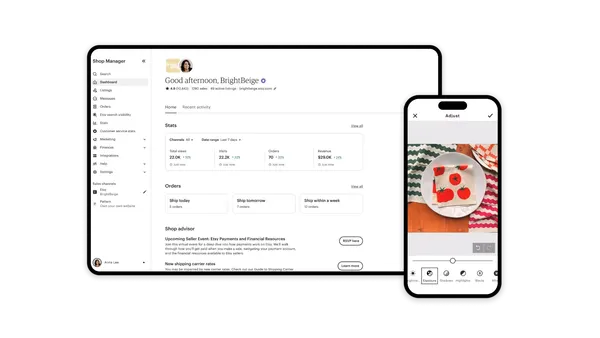With the new year comes a fresh slate full of opportunity, and what you do in the beginning of the year can help set you up for success in the months to come. Here are four priorities to help you optimize your small business for 2023.
1. Highlight your unique benefits that will resonate with customers.
Small businesses have an advantage that should never be overlooked, given the high regard consumers have for them as a crucial part of the local fabric. In fact, a recent survey commissioned by American Express and PayPal, and conducted by StudioID’s Retail Dive, found that 93.9% of survey respondents agree small businesses are important to a community.
That puts you in an excellent position to attract and retain customers by engaging with them and creating relationships that inspire loyalty. One strategy that can be successful is spotlighting how your business reflects the community. Shopping at stores that are welcoming and inclusive is important to 83% of those surveyed, according to a recent poll of 550 small business leaders conducted by KabbageTM from American Express. **
“Small business owners are often able to connect with their customers and community on a more personal level,” says Katharine Kirk, Vice President of Merchant Value & Partner Marketing for American Express. “Curating experiences and products that align with their values (e.g. locally-sourced, planet friendly, minority-owned), partnering with local organizations or hosting a charity event unlocks opportunities to expand relationships with local customers and build trust within the community.”
2. Experiment with new marketing mediums.
Small businesses may find one of their biggest challenges is alerting local shoppers to their presence and points of differentiation. The great news is there are so many ways to reach your customers with targeted messages that you can select those which best align with your time and monetary resources.
Respondents to the American Express/PayPal survey were invited to choose up to three marketing mediums that entice them to visit a store in person or online and the wide range of answers shows that anything and everything goes from a marketing perspective:
-
Direct mail (flyer/postcard to shopper’s residence): 27.8%
-
Event held by a favorite store: 25.5%
-
Social media posts from the merchant: 25.3%
-
Advertising on traditional broadcast channels (radio/TV): 22.0%
-
Signage: 21.7%
-
Email or SMS message that shopper opted in for: 21.7%
-
Event held by several stores in the same vicinity: 21.7%
“It’s important for small businesses to leverage a variety of marketing channels in order to maximize reach,” Kirk notes. “We know that one size does not fit all when it comes to marketing, and that the most successful campaigns are those that take an omni-channel and multi-touch approach.”
That means one day you might have staff create fun social media posts highlighting new merchandise, and the next you might target adjacent neighborhoods with an eye-catching flyer. Don’t shy away from experimenting with various strategies, but make sure to track responses when trying new marketing methods so you can evaluate where your dollars are achieving the most success.
3. Audit your checkout experience.
First impressions count, but so do lasting impressions and your checkout experience is your final opportunity to impress your guest. It’s important to optimize for a safe and secure checkout; according to the American Express/PayPal survey, the feature most important to shoppers in the payment experience—cited by 81.1%—is that their payment information is secure. One way you can help instill confidence in your security measures is to post logos of respected companies, like American Express and PayPal, along with “trust badges,” which let visitors know their data is being collected securely.
The feature cited second most often—by 49.5%—was that their preferred payment option is available. In fact, 56.9% of respondents place some level of importance on the ability to pay with a mobile wallet, using a solution like PayPal, ApplePay, etc.
“Enabling choice in payment options when it comes to checkout can help businesses drive sales, increase revenues and drive customer loyalty,” said Ed Hallett, Senior Director of Small Business Solutions at PayPal. “That’s why it’s important for small businesses to offer a range of payment options at checkout, including cards, popular digital wallets and even flexible buy now, pay later solutions.”
4. Promote “value” rather than relying on discounts.
It’s no secret that today’s customers are watching their wallets. The American Express/PayPal survey found that 73.2% of respondents say better pricing and promotions would earn more of their business. However, that doesn’t mean small businesses should indiscriminately slash prices, which can hurt profit margins more than it might for a larger company with higher volume.
The key to offering value and not just discounts, is to avoid an across-the-board approach. For example, be selective with your discounts, such as cutting the price only on less-popular or past-its-prime merchandise, rather than marking down all stock, including items that might otherwise sell at full price.
Small merchants can also be more thoughtful about how and when to offer promotions, such as reserving them for loyalty club members to recognize birthdays or reward them for recommending your store to their friends and family.
Are you ready for a successful 2023?
For small businesses, the new year offers fresh opportunities to flourish and American Express stands behind you. As you finalize your 2023 Q1 game plan, take advantage of every support available. Visit the American Express Shop Small® Resource Hub for free materials today that can help you reach customers where they are and start 2023 off on the right foot.
American Express & PayPal commissioned an online survey to US consumers, conducted by StudioID’s Retail Dive in October 2022. 396 respondents provided input on their small business hopping sentiments. Survey respondents were 18 years of age or older and indicated doing more than 50% of their household’s shopping.
**The online survey was conducted between September 20th – October 3rd, 2022, surveying 550 small business leaders, including 250 at the smallest small businesses (<10 employees), 200 at medium small businesses (11-100 employees) and 100 at the largest small businesses (101-500 employees). Respondents represented industries across retail, marketing, healthcare, financial services, technology, food and beverage, construction, automotive, manufacturing, media, professional services, education, agriculture and more. The margin of error for the full sample is +/- 3 percentage points.










